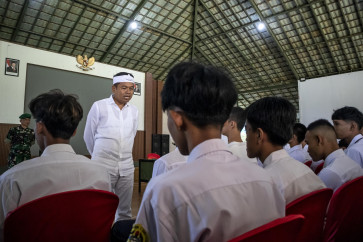Popular Reads
Top Results
Can't find what you're looking for?
View all search resultsPopular Reads
Top Results
Can't find what you're looking for?
View all search resultsCooking in silence in Cikondang
At work: Women of the community are seen preparing a special meal for the residents of Cikondang
Change text size
Gift Premium Articles
to Anyone

At work: Women of the community are seen preparing a special meal for the residents of Cikondang.
Cikondang is a traditional farming hamlet of just under 400 people located in the foothills of Mount Tilu in Pangalengan, Bandung regency, West Java.
According to Ilin Dansyah, an elder of the kampung, people in Cikondang observe Wuku Taun, the start of the Islamic New Year, as a special moment to give thanks to God and to offer prayers for a more prosperous new year.
Wuku Taun, a Sundanese tradition, is practiced throughout the Pasundan region. Wuku literally means 'book' in Sundanese, while taun means 'year'.
In Cikondang, which takes its name from a spring (or ci) that used to run under a kodang (ficus) tree, the tradition has been followed since at least the 17th century.
'Wuku Taun is a time for the people of Cikondang to conduct silaturahim,' Ilin Dansyah said.
Silaturahim literally means keeping in contact or establishing compassion.
The observance of Wuku Taun begins on the first day of the month of Muharram, the first month of the Islamic year.
The kampung itself spans three hectares, including a traditional Sundanese wooden stilt house; a leuit, or place for storing rice; the bale budaya, used for meetings and cultural events; the leuweng larangan, or forbidden forest; and two sacred graves.

Passing through the bamboo gates, the stilted house with its bilik, or bamboo-plaited walls, is immediately visible. Its roof is made of ijuk palm fibers.
The tiny house, which faces north, is currently a heritage building and is not permanently occupied. It has only one door and five windows. Firewood is piled up outside.
There were 60 such stilted wooden houses with ijuk roofs in Cikondang before a huge fire in the 1940s destroyed all but one.
No one knows exactly how the conflagration broke out, according to Anom Juhana, another elder of the community.
'During the 1940s, Cikondang became the stronghold of the Indonesian guerrillas fighting against the Dutch,' Anom Juhana recalles. 'It is believed that the Dutch army might have burned down the village.'
On the peak of Wuku Taun, which falls 15 days after the month of Muharram begins, the head of the village, the elders of the community, the subdistrict head and other guests, gather around to pray at the stilt house.
Meanwhile, not too far way, women of the community were seen preparing a special meal for the residents of Cikondang.
The meal, to be shared by all, featured a sangu tumpeng cone-shaped rice dish, specially raised chickens called hayam kampong, and twelve kinds of traditional food to symbolize each month on the Islamic calendar. The hayam kampong, or free-range chickens, naturally have feathers of various colors, as opposed to the white-and-brown plumage typically sported by hayam negeri, which are larger and are mass-bred in cages.

While hayam negeri are said to be larger, the hayam kampong have a reputation for a better taste when served.
In Cikondang, residents breed the hayam kampong to produce white, black or even grey birds for the meal.
According to local tradition, the white chickens symbolize healthy bodies and spirits; the black chickens, commitment; while the grey symbolize clean and sincere minds.
The chickens will be slaughtered, cooked and then served alongside the sangu tumpeng.
The women start early in the morning and spend about six hours cooking three main tumpeng and hundreds of additional smaller tumpeng.
However, only women who are blood relatives of the village chief are allowed to cook the sangu tumpeng. There are other requirements, too: The women must fast before cooking ' and while they cook, the women cannot speak at all.
Cikondang is a customary (adat) community, protected by law, and offers a rare chance to see a traditional Sundanese village.
Residents of Cikondang still observe several taboos, such as declining to build houses made from brick or with too many doors, declining to sleep facing north, and declining to hunt or cut down trees in the forbidden forest.
The kampung welcomes visitors. Cikondang is situated about 800 meters from the main road between Pangalengan and Banjaran, which is about 40 kilometers from Bandung, the provincial capital, and about 200 kilometers from Jakarta.
Cikondang can be reached by minibuses serving the Bandung-Pangalengan route. Just get off at Lamajang.
But if you can, arrive by foot from the road to more fully enjoy the natural beauty of Cikondang and its residents.




Photos by Djoko Subinarto









